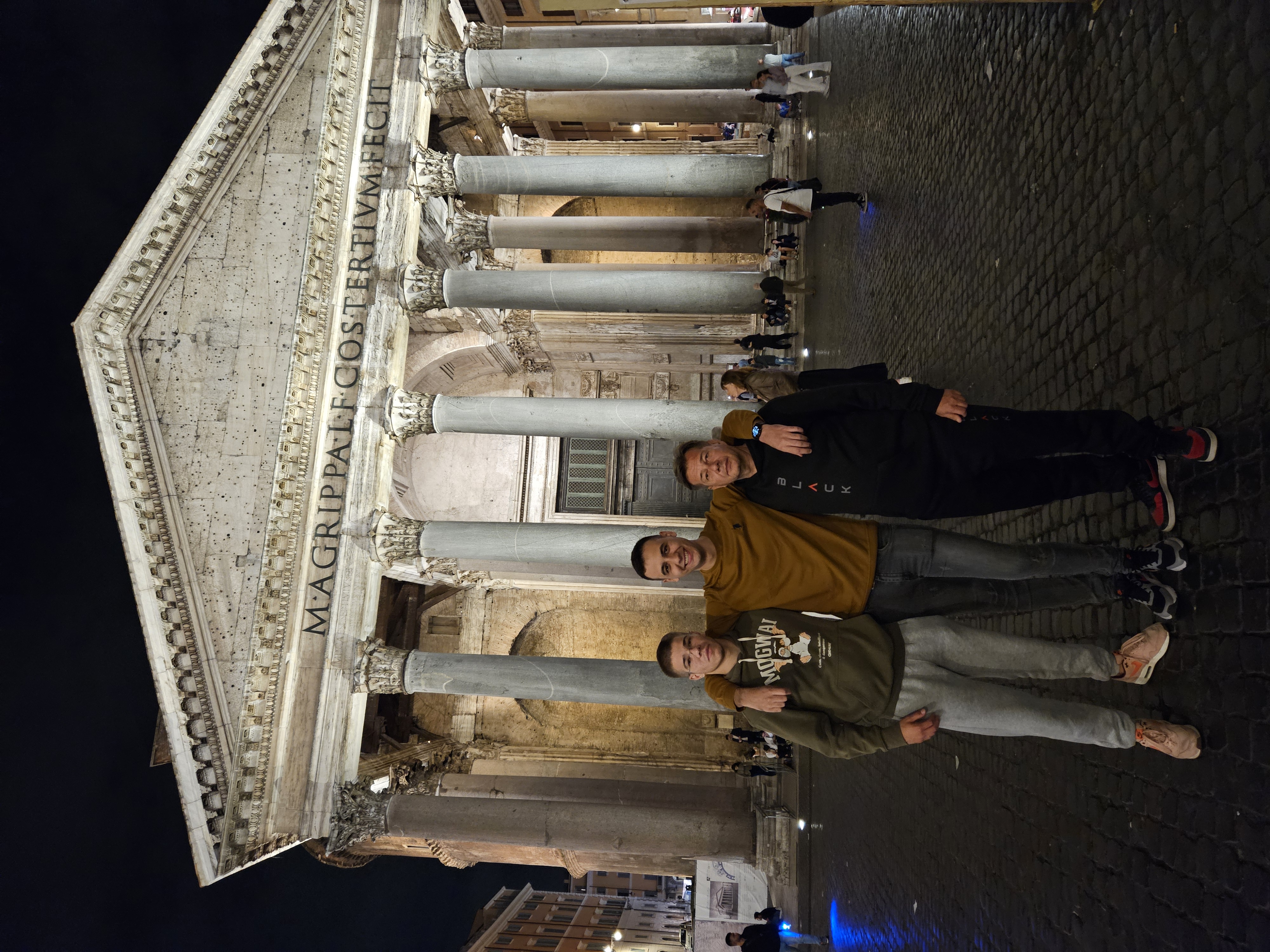Rome, a beautiful city, full of architecture, wherever you turn there are some interesting buildings, some less, some more famous, but all of them at the end of the day have the same importance, they carry some history with them. Rome is a whole history in itself, a huge city in which you will never be bored. Every day we visited several significant buildings. The first one we visited, and which we came across when we started walking around Rome, is exactly the one I will write to you about today. Let's take a look at the Pantheon.

Pantheon - The pinnacle of Roman architecture
The Pantheon in Rome is one of the most impressive and best-preserved monuments of ancient Rome. It was built during the reign of Emperor Hadrian between 118 and 128 AD, on the site of an earlier structure built by Marcus Agrippa.

Architectural wonders
The Dome: The most notable feature of the Pantheon is its enormous dome, which at the time of its construction was the largest in the world. With a diameter of 43.3 meters, it rises to a height of 43.3 meters, forming a perfect radius. In the center of the dome is the oculus, a circular opening 9 meters in diameter, which is the only source of natural light in the interior.
Portico: The front of the Pantheon is a portico with eight Corinthian granite columns, which support a three-part pediment. This portico is inspired by Greek architecture and is an introduction to the monumentality of the interior.

The inscription above the entrance to the Pantheon in Rome reads:
M. AGRIPPA L. F. COS TERTIUM FECIT
Which means:
M. AGRIPPA: Marcus Agrippa, the name of the person who commissioned the construction.
L. F.: Lucius filius, meaning "son of Lucius".
COS TERTIUM: Consul tertium, meaning "consul for the third time".
FECIT: Fecit, meaning "made" or "built".
So the inscription says that Marcus Agrippa, son of Lucius, who was consul for the third time, built this temple.
This inscription is actually preserved from a previous temple that stood on the same site, which was built by Marcus Agrippa. The current Pantheon was built during the reign of Emperor Hadrian, but the original inscription was retained as a sign of respect for Agrippa.


Interior
The interior of the Pantheon is extremely spacious and bright, thanks to the large oculus. The walls are decorated with niches that once housed statues of gods, and the floor is covered with marble tiles. In later periods, the Pantheon became the tomb of many famous figures, including Raphael, Victor Emmanuel II, and Queen Margherita of Savoy.
Enduring Inspiration
The Pantheon has served as an inspiration to architects around the world for centuries. Its perfect geometry, monumentality, and magnificent dome remain a symbol of Roman architecture and engineering achievement to this day.



Michelangelo is not buried in the Pantheon.
Although the Pantheon has become a prestigious burial place for many artists and prominent figures, Michelangelo is buried in another equally important place for art.
Where is Michelangelo buried? His tomb is in the Basilica of Santa Croce in Florence. This basilica is known as the "templum gloriae" (temple of glory), as several of Italy's greatest artists and thinkers are buried there, including Dante Alighieri, Galileo Galilei, and Niccolò Machiavelli.

Why Santa Croce? Florence was Michelangelo's birthplace and the city where he spent much of his life. Santa Croce was associated with the Franciscans, and Michelangelo was a great admirer of this order. In addition, the basilica was known as the burial place of prominent Florentines.
What does Michelangelo's tomb look like? His tomb is a magnificent work of art in itself, decorated with sculptures and reliefs depicting scenes from his life and work. It is a worthy monument to one of the greatest artists of all time.
Why did this confusion arise? Perhaps the confusion arose because many other artists and prominent figures were buried in the Pantheon, and it is assumed that Michelangelo found his final resting place there. Also, the grandeur of the Pantheon and its association with art make it a logical place for the burial of a great artist such as Michelangelo.

You can check out this post and your own profile on the map. Be part of the Worldmappin Community and join our Discord Channel to get in touch with other travelers, ask questions or just be updated on our latest features.
Congratulations, your post has been added to the TravelFeed Map! 🎉🥳🌴
Did you know you have your own profile map?
And every post has their own map too!
Want to have your post on the map too?
- Go to TravelFeed Map
- Click the create pin button
- Drag the marker to where your post should be. Zoom in if needed or use the search bar (top right).
- Copy and paste the generated code in your post (any Hive frontend)
- Or login with Hive Keychain or Hivesigner and click "create post" to post to Hive directly from TravelFeed
- Congrats, your post is now on the map!
PS: You can import your previous Pinmapple posts to the TravelFeed map.Opt Out
Congratulations @sniki003! You received the biggest smile and some love from TravelFeed! Keep up the amazing blog. 😍
Thanks for using TravelFeed!
@for91days (TravelFeed team)
PS: Did you know that we have our own Hive frontend at TravelFeed.com? For your next travel post, log in to TravelFeed with Hive Keychain or Hivesigner and take advantage of our exclusive features for travel bloggers.